It’s known as the Cathedral of Kings and Angels, but the claim of a thousand statues is off by a mile. It’s just a general description. This magnificent church is actually home to 2,303 carved statues (yes, some very diligent person actually counted them all!)
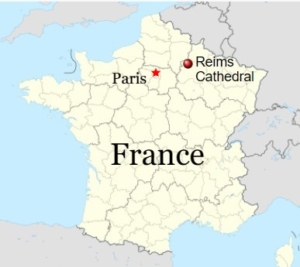 Rheims Cathedral in Northern France stands on the very spot where Clovis, the King of the Franks, was baptized in 498 AD. In fact, at the lowest level of the building they have unearthed what they consider to be the very baptismal font of the first king of France. Fifty-five more kings would sit on the throne in the next 1400 years, and most of them would be crowned in this very cathedral.
Rheims Cathedral in Northern France stands on the very spot where Clovis, the King of the Franks, was baptized in 498 AD. In fact, at the lowest level of the building they have unearthed what they consider to be the very baptismal font of the first king of France. Fifty-five more kings would sit on the throne in the next 1400 years, and most of them would be crowned in this very cathedral.
After the ancient church had burned down in 1210, it was rebuilt in its present Gothic style by ingenious medieval architects. The roof caught fire in 1481, and in the early 1790s, the French Revolutionary radicals took hammers to the statues and plundered all the precious vessels.
Then it was destroyed by German bombs in World War I and raised again, fortified by fireproof materials, and restored to its original glory. On that occasion, the fire that destroyed the roof burned so hot that it made molten lead flow through the mouths of the gargoyles on the façade.
But it is not all a tale of sorrow and destruction either. In perhaps its most glorious moment, St. Joan of Arc stood in the sanctuary while her king (Charles VII) was crowned there in 1429. It was also the scene of the reconciliation of the German and French peoples in 1962 when Charles De Gaulle and Konrad Adenauer – both Catholics – signed a pact to raise Europe from the ashes of the Second World War and confirmed their oath in the holy sacrifice of the Mass at Rheims
It’s hard to imagine a single building that has seen more history and lived more human trauma than this cathedral, which, despite it all, continues to exude the glory of the ancient faith of France, “the eldest daughter of the Church.”
Behold the sheer beauty of Rheims Cathedral!
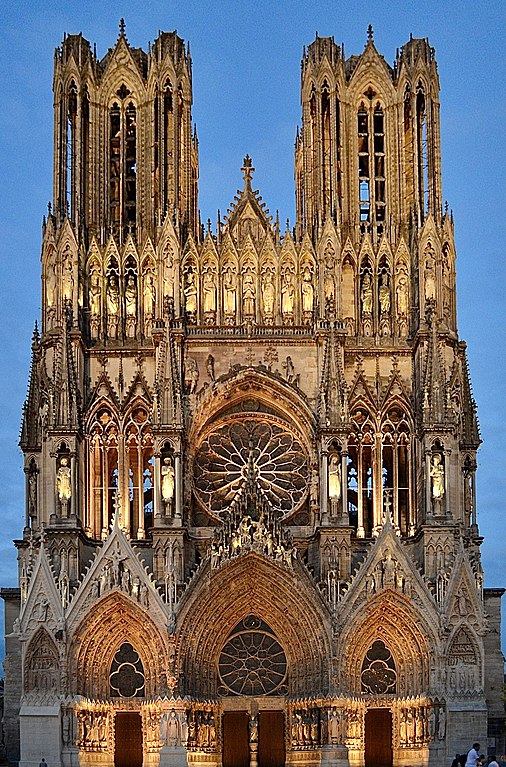
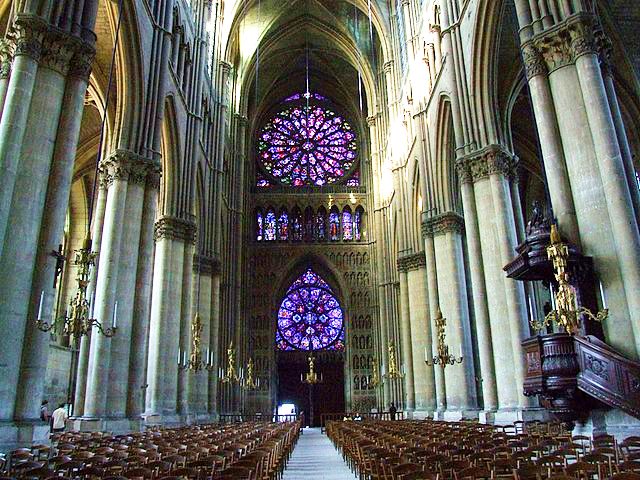
(Rheims is often spelled Reims, and its French pronunciation sounds much like “Ranz” to the English ear. There is no a, n, or z in the name Rheims, but I never second-guess the French on language!)
Inspiration in Stone and Glass
Having visited the Cathedral myself a few years ago, I can attest to the sheer magnificence of this glorious temple that makes your jaw drop as you approach it from the main street of the city. It seems as if the buildings of the street were constructed as a kind of frame for viewing the cathedral in the distance. On the approach, the buildings then funnel the visitor toward it, and the church grows in immensity until one is standing at the front door.

As a matter of fact, it’s hard to get a perspective on the size of this structure until you are actually standing in front of it looking up at a thousand statues. The twin towers rise 266 feet over you – and you cannot help but feel very, very, very small in the scene.
The historian Sven Stolpe described what it must have been like for Joan of Arc, born into peasant circumstances, to come upon this cathedral as she led her king to his coronation:
It may have been the first truly great Cathedral that Joan had seen. Far out on the plane the great towers had become visible, but as she got nearer, the massive building seemed as if it were raised up high by the widespread wings of angels. In amazement she had stood, small and insignificant, before the majestic façade.
…The hall of human life is mirrored in these portals, the cathedral is not only the center of the daily life; it is a symbol of the cosmos of man with all its facets. Joan knows that in this world she has her place, just like one of the small figures in a weather-worn frieze – small almost invisible, but still belonging, an intrinsic part of the structure of holiness. (The Maid of Orleans, Ignatius, 2014, 152–153.)
It is amazing to realize that the resourceful architects of the age built this cathedral without cranes, without electric tools or powered instruments of any kind, and with no modern vehicles to transport tons of stone, wood, bricks, and personnel to the site.
It took eighty years to complete the raw structure (with various additions and renovations in future centuries). Modern man has the tools but not the patience for such a project! – or perhaps even the interest, for that matter!
Of Portals and Kings
As Stolpe noted, the moment you set eyes on this beautiful monument of Christian faith, you feel immersed in a sacred cosmos, a seamless permeation of the natural, human, and angelic worlds. Both the external façade and interior are replete with statues of animals, various depictions of saints and commoners, flowers and plants, as well as a super-abundance of angels who are all our companions in the great drama of life.
You may have seen an image of Rheims’ most famous tenant – the Smiling Angel – who stands immediately next to the main portal and greets all visitors and pilgrims. What a nice medieval touch! But he is just one of thousands of angels and saints that look down on pilgrims from both the outside and the inside of the building.
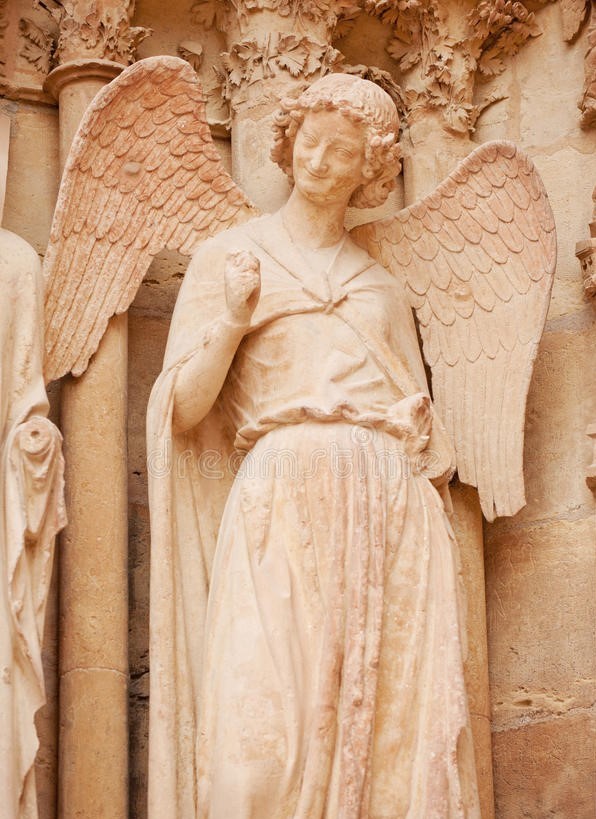
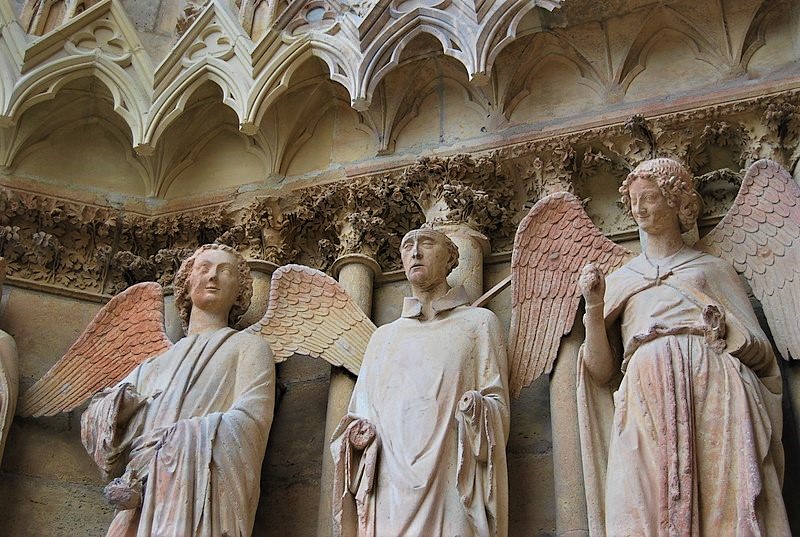
The Western façade holds pride of place in this collection. It is called the “Gallery of Kings” which features 56 statues of French kings, each standing 15 feet tall and dressed in royal regalia as befitting their rank. There are different estimates of how many kings were actually crowned in this cathedral (some say 25, others 33) but what is indisputable is that the French considered the kingship a sacred office, and they anointed their kings to indicate that these men through the ages ruled by God’s will and blessing.
The Interior: Stained Glass
It’s hard to decide which element is the most striking aspect of the Cathedral’s interior: the stained glass windows, the soaring Gothic arches, or the small chapel of St. Joan of Arc (well, this last one is my favorite…but only by a little).
Sadly, just a few of the stained glass windows in Rheims are original 13th century creations. Up until the First World War, there were thirty-six original medieval stained glass panels in the nave (central aisle) but only four of them survived the bombings (didn’t they think to take them down?)
The magnificent rose window in the north transept (the arms of a cross-shaped building) is also original, and it is truly stunning. Medieval stained glass work is another instance where you shake your head and wonder how they actually accomplished such perfection in art. The many other stained glass windows are indescribably beautiful.
Of the modern windows, several stand out. Of the modern windows, several stand out. Three windows in the center chapel behind the sanctuary manifest the lush and striking hues of the famous stained glass artist, Marc Chagall (installed in 1974). They pour forth cascades of radiant color into the darkened spaces and dazzle the eye.
My favorite stained glass creations by far, though, are the three windows dedicated to Dom Perignon, the Benedictine monk who created champagne! In case you didn’t know, the city of Rheims is the capital of the Champagne Region in northern France, so there’s quite a bit of local pride in these windows.
The Interior: Gothic Arches
When you walk into the Cathedral, again, you cannot help but feel overawed by the soaring architecture which takes your breath away from the very first moment you look up. It’s as if you just found yourself in a forest of elegantly carved stone redwoods which converge in a canopy 150 feet above you. The pointed arches, as they’re called, are another magnificent Gothic creation meant to resemble praying hands pointed upward so that the worshipper would always have his eyes and his heart raised to heaven in prayer.
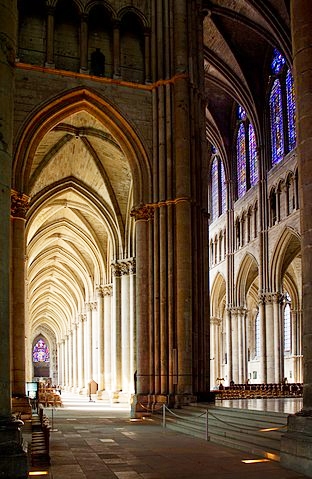 A radical silence pervades the environment and is not enforced by priests or monks standing over you. It’s more a question of not being able to speak when you are so busy being overwhelmed looking up into all those sacred windows and forms of grace. The gentle splendor of sheer reverence envelops your soul there.
A radical silence pervades the environment and is not enforced by priests or monks standing over you. It’s more a question of not being able to speak when you are so busy being overwhelmed looking up into all those sacred windows and forms of grace. The gentle splendor of sheer reverence envelops your soul there.
There is one view, however, you must drink in when you go there. If you stand at the back of the cathedral in one of the side aisles and look toward the front door, you will see a brilliant cascade as the lower gothic arches of the side aisle lead your eye in a kind of telescoping manner down the rows of columns to the rose window in the front portal. Only when your church is 455 feet long can you achieve this effect! It’s just magic.
The overall experience of Rheims is grace-filled. On my trip there, I remember entering the cathedral at the moment the massive ten-ton carillon bell in the south tower began to ring for the Noon Angelus. There had just been a ceremony with incense the hour before, and the midday sun was gently coursing through the stained glass windows. In short, all my senses became instantly enlivened and my soul entranced as I looked around and up, and my heart was raised in prayer – exactly as the medieval architects had intended.
The Interior: Joan of Arc
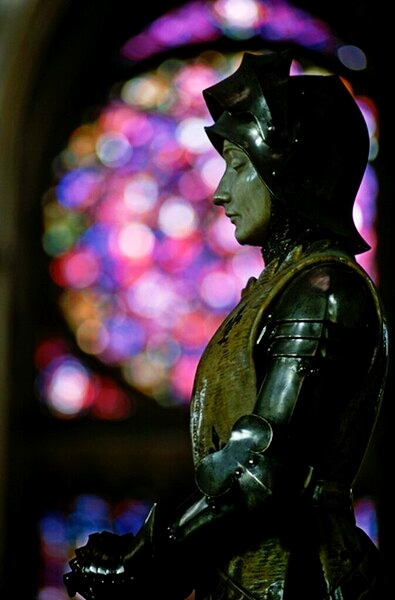
The best aspect of Rheims for me was knowing that Joan of Arc herself had once walked those same aisles and stood in those same hallowed halls looking around and up like me. There used to be a marker in the sanctuary designating the exact spot where Joan stood in full regalia holding her war banner during the coronation of Charles VII, but – alas! – centuries of renovations (and carelessness) have wiped out the memory of the precise location.
Going around the sanctuary toward the back and to the left, you will find the side chapel dedicated to France’s heroine, which is crowned by three modern stained glass windows today. That humble, silent space displays a statue of a petite female figure standing (at the coronation) enrapt as it were in the spiritual grace of having completed her mission to get the king crowned at Rheims (which occurred on July 17th of 1429).
Behind her image, on the wall, is a replica of the 12-foot battle standard she carried thundering into battle as the chosen warrior princess of the French kingdom – and of God’s kingdom above all.
Views of Magnificence
My only regret back then is that I could not stay and dwell longer with her on that moment of victory. (The Feast of Epiphany is the traditional date of Joan’s birthday, so her life and greatest victory are fitting subjects for our contemplation.) My only regret at this moment is that a short newsletter cannot do justice to the experience of the Cathedral of a thousand statues.
To compensate for these limitations, I invite you to take a moment to view the short video of France’s third most famous cathedral, Notre-Dame de Rheims (often called “the other Notre Dame” in deference to the more famous Notre Dames in Paris and Chartres) Our Lady was well-honored in Medieval France indeed.
The modern visual arts will give you a view of that glory that you can only really understand by going there to experience the Cathedral of Kings and Angels firsthand.
Video
Cathédrale de Reims (duration, 4:14)
———-
[Note: This article is a reproduction of the Sacred Windows Email Newsletter of 1/8/23, so it does not end with the regular Soul Work section. Please visit our Newsletter Archives.]
Photo Credits: All Wikimedia unless otherwise noted. Feature (Fab5669); Façade (Clelie Mascaret); Interior Nave (Mattana); Main Street (Johan Bakker); Smiling Angel (Elena Tatiana Chis); Portals (Mattana); Gallery (Fab5669); Sculptures (Tony Bowden); Windows: (Vassil 1), (Fab5669 3), (Ad Meskens 2 & 4), (Bastenbas 5); Side Aisle (Johan Bakker); Joan of Arc (Flickr).
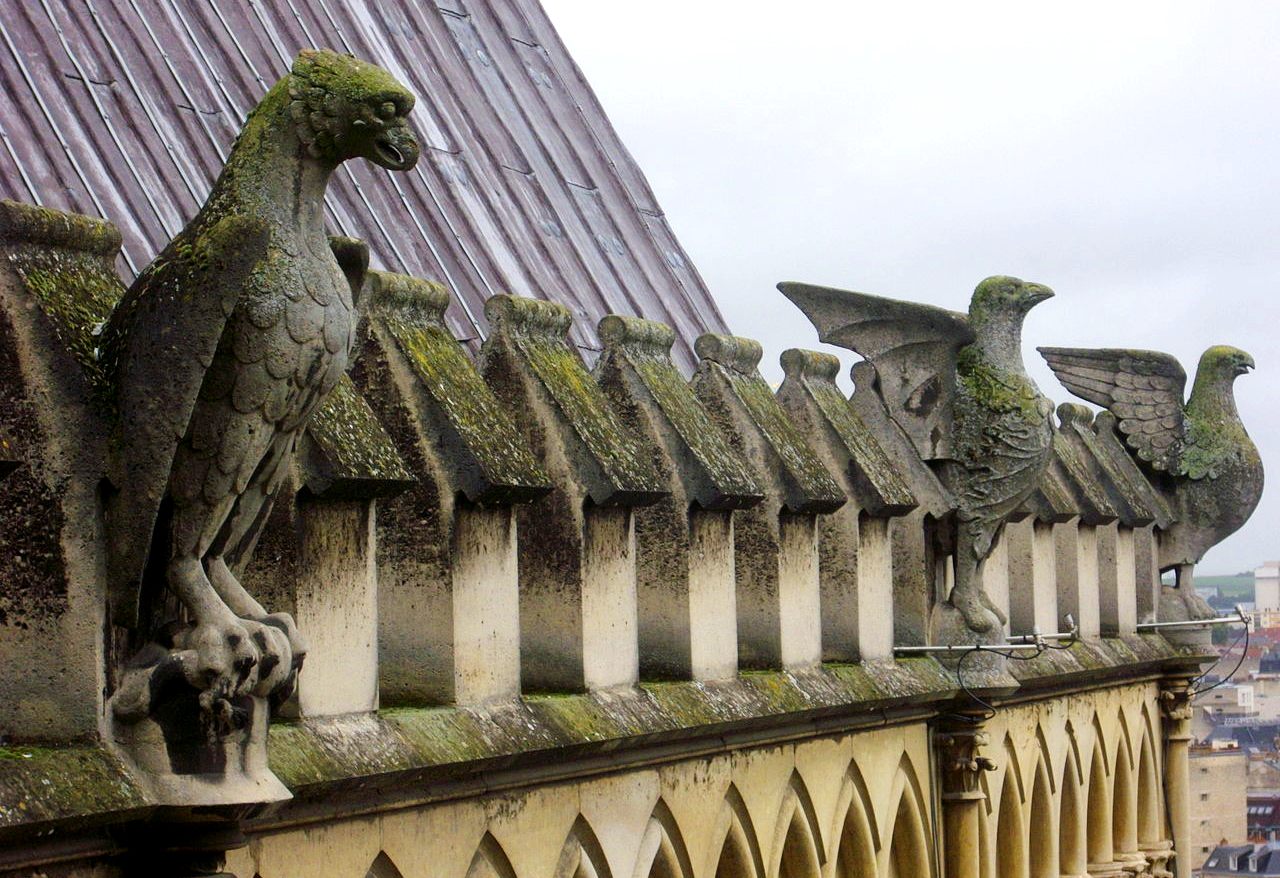
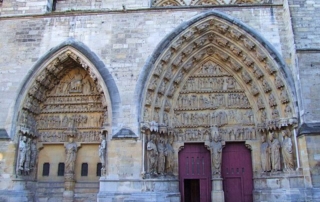
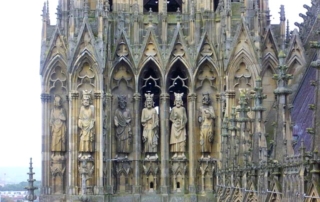
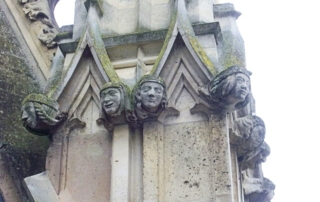
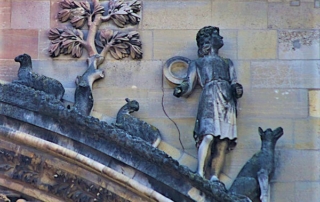
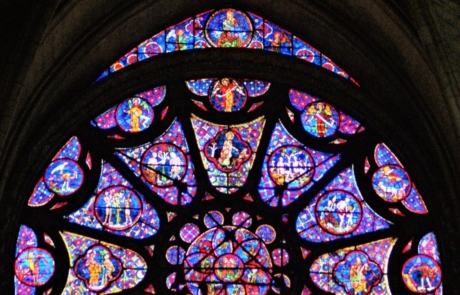
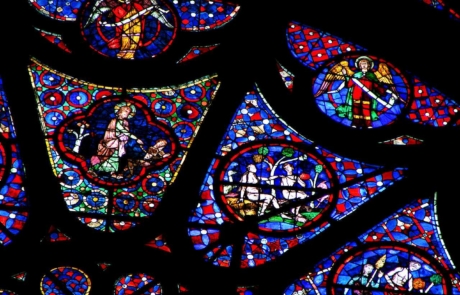
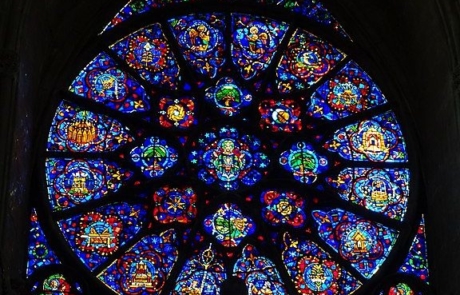
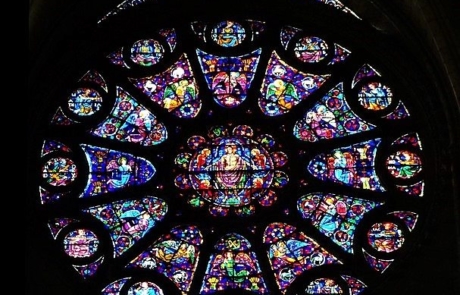

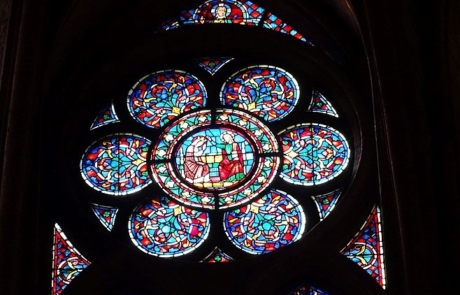
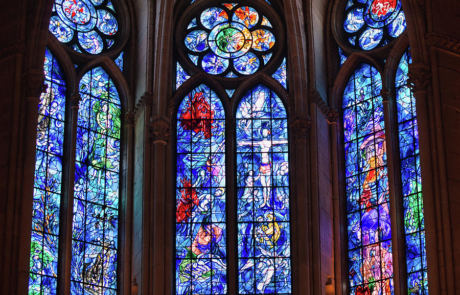
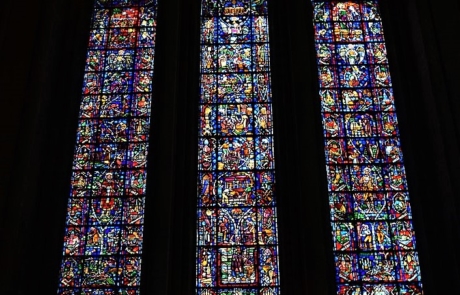



Leave A Comment